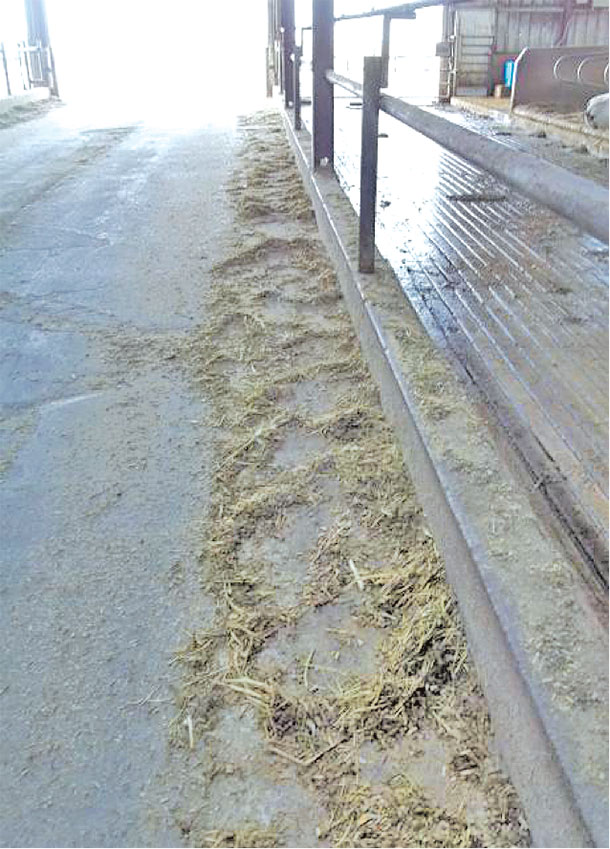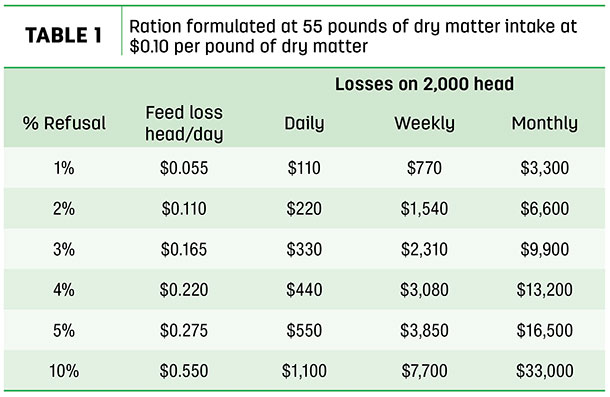To complement this, we manage feedbunks to get a consistent and stable fermentation in the rumen, which improves the efficiency of our diet and the output of the cow.

We want to deliver feed at the same time, with the same quality and adequate quantity every day. This consistency and a close eye on their consumption is important. When cows don’t eat the amount of feed delivered, they won’t receive the intended amount of nutrients balanced for their needs.
On the other hand, if they consume all of it, we don’t know if they would have eaten more had it been available to them. Either outcome can result in a loss of production or have a negative impact in other areas of performance.
Feedbunks: 3 things to ‘read’
Proper bunk management begins with reading the bunk before new feed is delivered. Three things an owner/manager/feeder should track when reading a bunk are quantity, consistency and time of day observed. The readings themselves should be done by the same person every time. In the case of shared responsibility, extra communication and training might be needed to ensure each responsible party is measuring the bunks in the same consistent manner as the other.
Reading bunks requires an individual to be very observant, not only to the appearance of the bunk but also to cattle behavior when fed. There are just a few tools needed for proper bunk management: a simple spreadsheet to track bunk scores with at least a couple of days of previous corresponding bunk scores, target feeding rates for specific groups of cows/pens (rations) and a feed delivery schedule.
Dairy cattle naturally show their most aggressive eating behavior at daybreak. If the bunk is slick at daybreak, how do you know if it’s been empty for an hour or five hours? Empty bunks in the morning mean cattle will miss some opportunity to eat, and more meal opportunities mean more milk.
Milking cows should be fed for a minimum of 1 to 2 percent of their daily intake left after a 24-hour feeding period. Prepartum and postpartum cows should be fed for a minimum of 5 percent or more of daily feed intake left in the feedbunk.
Too little feed delivered could cause aggressive feeding behavior, or “slug feeding,” and will ultimately cause rumen pH fluctuations and throw off fermentation or cause a mass of other metabolic issues. On the other hand, excess feed can eat away at a dairy’s profitability. Table 1 is an example of a 2,000-cow milking herd with a ration formulated to 55 pounds of dry matter and a feed cost at 10 cents per pound of dry matter.

As you can see, refusals exceeding 2 percent can become quite costly if not managed well.
There are various templates of feedbunk scorecards that allow you to score your feedbunk. Penn State researchers have developed a scorecard which scores feedbunks from 0 to 5. The breakdown is as follows:
0 = no feed remaining from the previous feeding
1 = less than 5 percent feed remaining
2 = 10 percent feed remaining
3 = 25 percent feed remaining (and less than a 3-inch depth of feed)
4 = 50 percent feed remaining (and more than a 3-inch depth of feed)
5 = untouched feed
Read your bunks daily. The cattle will tell you whether to feed them more, less or to hold them at the current rate. You can score your bunks accordingly and make changes if need be in your feed delivery system. It is important to note you do not want to start out with too little refusals for the sake of saving money.
Providing an opportunity for cows to eat an extra pound of dry matter could translate into 2 more pounds of milk. Start off feeding your cows graciously and trim down the refusals to meet the needs of your dairy farm.
Quality of feed not only deals with the makeup of the TMR but also with the delivery. Delivery of feed should be even throughout the manger. Inconsistencies in feed distribution will cause some areas to become thin or empty of feed. When this happens, cattle begin to exhibit “grazing” behavior to find feed, increasing competitive interactions among cattle and potentially causing missed meal opportunities.
Assess what’s left
When assessing the quality of feed left in the bunk, ask yourself these questions: Is the leftover feed uniform in appearance? Are there longer particles left because cattle are sorting? Are the bunks dirty with buildup or wet from rain and snow? These are all questions to think about when reading bunks. Feed that has been left in bunks for extended periods of time can heat up/spoil and cause off-feed situations.
Check the temperature of the feed. If warm, determine which ingredients could be the cause and try to manage appropriately. Ideally, you want your refusals to look similar to the fresh feed delivered 24 hours before. Cows constantly push feed around while eating in search of components of the ration most desirable to them, which is why it is important to have a well-mixed ration to begin with and establish a routine push-up schedule that mixes and redistributes feed evenly in the bunks.
Changes in composition of the ration over time could cause some metabolic issues and inconsistencies in milk components. Make notes on what you see and consult with your nutritionist on the correct course of action. It may be as simple as changing the order of ingredient addition to the mixer, increasing mixing time after forages are added, less time after concentrates or just sharpening/replacing your mixer blades.
When it comes to refusals, never force cattle to clean up feed. If applicable, scrape bunks each morning prior to new feed being delivered to ensure the quality of the feed is never compromised, and always clean bunks that have rain and snow in them.
Watch the clock
A critical component of reading bunks is the consistency of the time of observation. Cows are creatures of habit; from time of feeding to taking a particular space in the bunk they prefer to feed from, they crave consistency. For this reason, cows should be fed at a consistent time each day, and the feed should be delivered evenly throughout the length of the feedbunk. Scoring bunks should be done on a consistent timeline as well.
Each bunk should be scored in the same order, at the same time of day and preferably prior to feeding. This will give the best opportunity to accurately score the bunk after the cows have had a 24-hour period of access to the feed. After the 24-hour period, assess what types of changes if any need to be made to the ration and implement as necessary prior to the next feeding.
In conclusion, implementing a bunk reading program is an excellent management tool to help manage dry matter intake (DMI) on dairy farms. Consistent timing and good record-keeping are key components to the success of this program and ultimately will have a positive effect on your production and your profitability. ![]()
PHOTO: Four-and-a-half percent refusals. Photo provided by Tom Oelberg, Diamond V.
Standard Dairy Consultants provides nutritional and management consulting services and is a division of Standard Nutrition Company. Standard blends custom dairy mineral and vitamin supplements with facilities in Iowa, Washington, Idaho and Texas.

-
Mike Brady
- Standard Dairy Consultants
- Email Mike Brady






